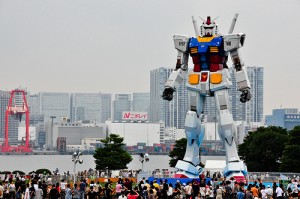For a nation working to capitalize its “soft power”, what is the role of anime and manga culture in governmental policies? The official answer is that anime, manga and digital art is both an important heritage and high-growth industry, requiring an official hub for preservation and presentation. Throw in a prime minister intent on leveraging his image as a manga enthusiast [1] into something, and we have one tentatively titled “National Center for Media Arts” on our hands.
It's hardly a new idea to build an institute to preserve and present the “media arts”, as the Japan Times tells us [2]. However, this one comes with a 11.7 billion JPY price tag approved in the government's FY2009 supplementary budget. It was only until Democratic Party of Japan President Yukio Hatoyama called the Center “a national manga cafe” that the project started to receive attention. Anime Dream gives the timeline in a Japanese animation industry roundup [3].
In a post titled “So pointless it's comical [5]“, the ever articulate Ampontan puts it like this:
Let’s be clear about this: This project is a perfect illustration of what people mean when they say they want to smash the Kasumigaseki bureaucracy [6]. Japan’s infamous Iron Triangle still exists. The three legs of the triangle are the bureaucracy, the legislature, and industry, and they’ve formed a unit for their mutual enrichment at the expense of the taxpayers. People usually associate the Iron Triangle with public works projects, including highways and bridges to nowhere, but this plan demonstrates there is no limit to the imagination of bureaucrats with nearly unlimited public funds at their disposal.
Blogger hannoumita compares the proposed Center [7] to New People World [8], the new Japanese pop culture-themed entertainment complex in San Francisco, and the national Musée de la Bande Dessinée [9] (Comic Strip Museum) in Angoulême.
日本においても、純粋に「アニメの殿堂」の良し悪しが語られているというよりも、年金や雇用の問題など他の政治課題とからめて語られている面もありますよね。それでも、何かフランスやアメリカの様子を見ると、ある意味「本家」である国としてどうなんだろうなあと思ってしまいます。
もう少し、他の問題とは切り離して考えてもいいのかもしれませんが、やっぱり今の世相がそこまでの余裕がなくなってしまっているということなのでしょうか。
I think we should examine the issue on its own, but perhaps our society doesn't have the latitude for that at the moment.
Matt Alt at AltJapan [10] writes about how some Japanese animators are opposed to the establishment of such a pricey and overbearing facility. Hiroshi Odagiri at Wired Vision [11] [ja] points out that cultivating culture as art, and cultivating entertainment for the masses as an industry are two very different things.
Syou Hayama at “Otaku Products Laboratory plus [12]” crafted a reply to the public call for opinions from the Agency of Cultural Affairs [13] [ja], proposing that the Center include all media pieces produced in Japan.
理念は
- 日本国内で生産されたメディア作品は、すべて収蔵する
- 収蔵した作品は、原則誰でも観覧できる
必ずしも商業的に成功する物ばかりではないので、マイナーな作品でも、価値のある作品を上映、観覧できる場所が欲しい。例えば終わったテレビシーズでも一週間交替で全話上映できると素晴らしい。
それと必ずしも「折り目正しいわけではない」ので、例えばロリータポルノに分類される「くりぃむレモン」であっても、正規の手続きがあれば観覧できる用にしなければなりません。18禁は未収蔵みたいな差別があってはならないのです。
- that all media pieces produced within the country be collected
- anybody is free to view works within the collection
Not all pieces are commercially successful, so I'd like for there to be a place that will play or present valuable works, even if they are minor ones. For example, it would be wonderful if the Center offered weekly viewings of television series that have already ended.
In addition, it doesn't have to be all “respectable”, so pieces like “Cream Lemon”, which is categorized as lolita porn, should be available for viewing to anyone who goes through an official registration process. There must be no discrimination against works just because they are banned for people under eighteen.
Blogger mojix [14] agrees with Tokyo University Professor Yasuki Hamano that “the Center will be a great asset to the country in a hundred years” but proposed that:
マンガだけでなく、芸術は一般に、政府が税金で守るのではなく、情熱を持った民間人が守ったほうがいい。なぜならば、芸術というのは特に「価値の判断」が難しいもので、それを政府ができるとは思えない。政府がやるとしても、どのみち民間の有識者に任せることになるのだから、最初から政府を介在させないほうがいい。
将来大きな財産になることが確かなのであれば、税金で保護するのではなく、むしろ民間から出資を募って、原画などを買い取るアーカイブ事業を起こし、その事業やコンテンツの権利を売ったほうがいいと思う。それならば税金のムダ使いも一切起こらず、事業の運営者も政府に口出しされず自由にやれて、(見通しと事業運営が正しければ)出資者も儲かって、マンガのアーカイブも守られるだろう。
If it's certain that the Center will become a great asset in the future, instead of trying to protect it with taxes, we should make a call for public investment, start an enterprise that archives original pieces, and sell that enterprise and rights. This way none of the taxpayer's money will be wasted, investors will be free from interference, and manga will be preserved.
With a summary of goals, enterprises and facilities of the Center, the general plan was green lighted on August 21st. An official plan will be submitted at the beginning of September and the Center, which will be a newly constructed or renovated building at a yet-to-be-decided location containing yet-to-be-decided content, will open its doors to the public in FY2011.
